We think of ourselves as sailors, but we all depend on reliable power to propel us in and out of harbor, through calms and often to assist in storms. A good diesel can provide 10,000 hours or more of faithful power, but this depends, more than anything, on good clean fuel of the right spec. Can additives help? Yes … and at the same time not with everything. They claim to improve lubricity, increase cetane, kill bugs, reduce corrosion, eliminate water and reduce sludge. Some of this can be true and as often it isn’t. They can’t fix engine problems. They are no substitute for good fuel storage practices. But they can bridge minor gaps in fuel quality and are an important part of any fuel management program.
Let’s begin with a quick tip. Never add any additive directly to a full tank. Many will separate or crystallize on contact, and then drop straight to the bottom of the tank. At best this is useless, and at worst they can foul filters. Instead, either pour the additive in while fueling or dilute it into a gallon of fuel and add that mixture to the tank.
Also, a caution: diesel exhaust fluid (DEF) is NOT an additive that you add to diesel fuel. Over-the-road diesel trucks use selective catalytic reduction to convert NOX in the exhaust to nitrogen and reduce emissions by injecting a chemical that is converted into ammonia when heated. The chemical (DEF) goes into a separate tank and does not apply to most sailing yacht auxiliary engines.
THE DIESEL BUG
Hydrocarbon Utilizing Microorganisms (HUM bugs for short) are a mix of fungi and bacteria that proliferate at the water/hydrocarbon interface in your tank and fuel lines. The greatest population will grow in the tank, where water may accumulate, but they also attach and thrive throughout the fuel system, as long as there is a trace of dissolved water in the fuel, and there often is. They contribute to corrosion through the weak acids generated during the metabolic process. When the population soars, or because a new batch of fuel causes a slight die-off, they slough from the tank and piping walls and clog filters and lines. An hour’s sail in rough water can scrub enough grime off the walls that can shut the engine down within minutes, right at some tight spot in the harbor. Hint: don’t start the engine just before you need it. Instead, start it 10 minutes early, so that any problems, such as clogged filters, have a chance to reveal themselves.
There are two solutions. The first is to keep the tank scrupulously free of water. The most common cause of water in the tanks is right through the filler. Replace the filler O-ring every two years or anytime it is worn, pinched or swollen. Is the filler in a drainage pathway? Relocate it. Is the vent well protected from following waves, excessive heel and green water on deck? If not, add a P-trap, a high loop and possibly move the vent higher.
WHAT ABOUT CONDENSATION?
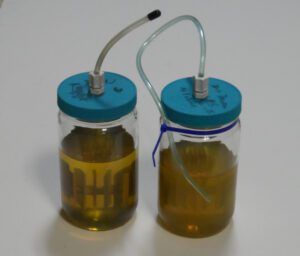
First, water does not need to condense in the fuel. It only needs to form a few droplets on the inside roof of the tank, which will then fall to the bottom. Even the fog aerosol itself, drawn in by a cooling tank, will do. Unlike an empty tank, where a droplet will evaporate when the sun rises and the tank warms, the droplet will have fallen through the diesel fuel to the bottom, where it is sealed from evaporation. If the boat is used regularly, the amount is miniscule and fresh fuel will easily absorb it. However, if the boat sits for months at a time, the fuel will reach saturation and hold no more.
The most reliable solution is a silica gel vent filter (see “Diesel Tank Vent Filters,” January 2014). The beads contained in the filter, similar to those in the tiny packets that accompany electronics, absorb water from the air that is breathed in. They also reduce breathing in the tank by damping out convective currents, reduce bacterial spore introduction and dramatically reduce evaporation in gasoline tanks. The gel lasts several years before requiring either replacement or regeneration (see “Marine Fuel Vent Filter Maintenance,” September 2018 for diesels and “EPA Mandate Sparks Fuel-Vent Filter Test,” January 2013 for gasoline.) Even if you run a diesel, the gasoline article is worth reading, as it expands further on the topic.
THE ZEN OF FILTRATION
Water-separating fuel filters are an essential part of any marine fuel system. Best known are Parker Filtration’s Racor systems. The baffles combined with a water-excluding filter element has proven very effective at eliminating free water. There are other brands, but make sure the primary filter has a drain you can check, and check the drain regularly, including shortly after spring start-up, after any sustained rain and after every fill-up. However, no filter will remove the dissolved portion of the water, even those that claim to be water-absorbing only remove tiny droplets.
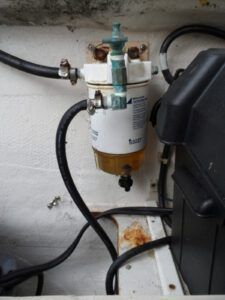
Sump your tank at least once per year, perhaps while you are changing the oil. Pump a small amount of fuel from the bottom of the tank, both to remove water and possibly some dirt, but also to see what it looks like. The simplest and safest way is to snake a hose or thin copper tube down through the filler pipe to the lowest point, though opening a small access point may be required.
The best pump is a manual pump-up vacuum oil change pump; it contains the fuel, has good suction and is non-sparking. Do NOT use a shop vacuum around diesel; although a cup of fuel will not ignite, the mist is quite explosive and I’ve witnessed a guy knock himself across a warehouse trying just that. He was very lucky. For the same reason I am ill at ease with drill-type pumps. Use a vacuum pump instead.
What about additives that claim to eliminate water? It should be obvious that they don’t eliminate water, they simply dissolve it. If it was saltwater, now it is going through the injectors. They are formulated using glycol ethers, common ingredients in paint removers and harsh cleaners such as Formula 409, which can have detrimental effects on gaskets and O-rings and lead to injector tip deposits. Many manufacturers recommend against water removing additives and so do we. Avoid any product that claims to eliminate water or prevent freezing.
THE SKINNY ON BIOCIDES
The second solution is regular maintenance treatment with a biocide. These are common in industry, and most jet fuel is treated with either Biobor JF or Kathon FP1.5. Cummins and others recommend treatment for storage over three months, but given the sporadic nature of boat use, that means always for most of us. (See “Diesel Additives Take On Contaminated Boat Fuel, July 2009). We favor oil-soluble biocides (Biobor JF) over water-soluble biocides (FPPF Killem, ValvTect BioGuard, and Racor Diesel Biocide) as they disperse more uniformly throughout the fuel system. ValvTect BioGuard sometimes forms precipitate if not well mixed.


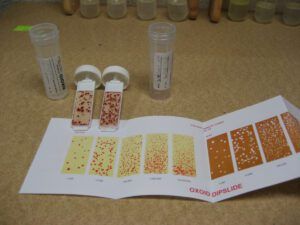
If you have a significant existing infection, do not expect an addition of biocide to solve your problems. It will kill the bugs, no doubt about that, but the dead bodies need to go somewhere. They will slough off the walls and clog your fuel lines and filters. A better approach is to clean the tank first to remove the bulk of the biomass. This does NOT need to be a perfect cleaning; even if you scrub it spotless you won’t get the bugs in the lines and hidden passages of the filter housing and engine. A shock treatment of a biocide will get those. You should expect some increase in increased filter maintenance even after cleaning and biocide treatment, until the tank turns over a few times. It’s like getting over any serious infection. There are many cleaning methods and most involve access through ports, pumping, scrubbing and maybe a power washer. (See “Do-It-Yourself Fuel Tanks Cleaning,” July 2018). As for fuel polishing services, we’ve heard mixed reviews, mostly imperfect for serious infections. You really need to get the tank empty and clean it right. And then vow to never to go through this again, taking the necessary steps to keep a dry tank and dose regularly with Biobor JF.
SLUDGE
Additives will claim to help here to, but again, the truth is they may help with new sludge and will not remove what is already there. Did you really want that gunk going through your injectors?
Where did the sludge come from anyway? In the US, federal law requires 10 micron filters at the pump. If the diesel pool were actually that dirty, truck drivers would riot. It’s not. Remote third-world supplies may be a different matter, but that is outside of our expert experience. As for bug-generated sludge, we just covered that.
If diesel can’t form sludge on its own, what causes it? In “Additives vs. Gum, Sludge,” November 2015 we aged samples at elevated temperatures following the American Society of Testing and Materials (ASTM) procedure to simulate long term storage. We found that both gasoline and diesel aged very, very little unless something else, more than just air and water, was added to the mix. The demon turned out to be copper and zinc from valves and piping. The metal ions serve as a catalyst, much like the platinum in a catalytic converter encourages reactions that won’t otherwise take place. In fact, both ASTM and EVERY engine manufacturer warn against copper and zinc parts in the fuel storage system for standby generators (see the excerpts below). Store one sample neat and the other with a penny and a brass valve and a few drops of water, and it will turn dark and drop sludge within a few years, all on its own.
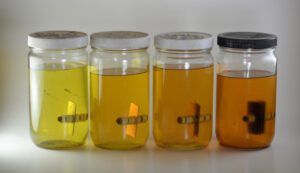
This is where asphaltenes come from in modern fuels. The refining processes required to make ultra-low sulfur diesel make spontaneous generation a thing of the past. Fortunately, we can fight this with dry fuel and the proper additives. No water means no metal ions in solution, so keeping the system scrupulously dry helps. An effective anti-corrosion additive, also referred to as a metal deactivator, will also keep metal ions out of solution; no corrosion, no effect on the fuel.
Reduce aluminum, brass, galvanized and copper to the extent practical. This means tanks cannot be made of these materials and copper tubing should be replaced with synthetic hose to the extent practical (not on-engine parts). Galvanized should not be used under any circumstances for anything, bronze is preferred over brass and stainless is preferred over other metals.

A WORD ABOUT ADDITIVES

What additives actually work? We have tested many of the common brands, and Power Service +Cetane Boost, Stanadyne Performance and Star Tron Enzyme Fuel Treatment stop corrosion. See also “Diesel Additives vs. Corrosion,” November 2018 for follow-up testing and more brands.
Lubricity. High-pressure injection pumps depend on the fuel for lubrication, and ultra-low sulfur (ULSD) diesel is less effective than the diesel of the past. However, before we pile onto the need for additives, remember that the fleet of trucks and diesel cars is still getting good durability. The manufacturers of modern engines have upgraded designs and materials to accommodate the new fuel, so unless there is some additional factor, such as dirt or water in the fuel, you should be OK. We spoke with a number of diesel mechanics, and their collective observation was that nearly all injector pump failures were the result of some combination of water in the fuel, acids from and fuel starvation from clogged filters caused by biocontamination. In other words, it was not clean fuel or poor lubricity that scorched the pumps and injectors, it was poor fuel management.
Though we have not performed lubricity testing of our own, we have scoured the web for independent testing, since we don’t take advertisement text at face value. The consistent performers seem to be Power Service +Cetane Boost, Stanadyne Performance, Biobor JF and Opti-lube; yet many provide no or little improvement. Another thing that caught our eye, though we cannot recommend it due to uncertainties, is 2-stroke oil at a 200:1 to 400:1 ratio. It makes sense, since it is intended to blend with fuel as it lubricates engines. The fuel-oil mix than undergoes the combustion process. The ratio is not that different from the treatment ratio of other additives. But we can’t recommend this practice due to uncertainty. The bottom line, for me, is that if I keep my fuel clean and dry and use Biobor JF as a biocide, it will function as a lubricity additive and there won’t be any water to cause cavitation damage. Done. I don’t need a separate lubricity additive.
Cetane. The EPA requirement for diesel cetane is 40, though typical test results are 42-45. Engine manufacturer requirements vary, but 42 is common. Cetane measures the speed of combustion. In subzero temperatures, when all sane boaters are cuddled up with a cup of warm coffee, higher cetane relates to better starting. California requires 53 and Texas requires 48 in 110 counties, both because higher cetane helps lower emissions in older engines. But high cetane does not automatically translate into better mileage or more power, just as higher octane gasoline does not translate into more power. That depends on engine calibration. Gasoline engines only benefit from high octane if the compression is so advanced and the compression ratio so high that pre-ignition (knocking) occurs. Same with diesels; if the timing and injection system is calibrated for 40-42 cetane, it is unlikely you would gain any benefit from switching to 50 cetane. Boosters, commonly containing 2-ethylhexyl nitrate or some relative will help, but we rank cetane improvement in the nice to have but not essential category.
Cold Flow. Diesel fuel is required to have a cloud point of 20 F minimum. Cloud point is the temperature below which diesel fuel becomes waxy in appearance. The number of cars and trucks happily plying the highways well below that temperature indicates you won’t have a problem. Additionally, very few boats in the water experience sub-freezing temperatures in the bilge and engine room. Even water with ice on it provides enough warmth that water in the bilge never freezes and bottles in the salon very seldom freeze. Unless you are a 4-season boater doing commercial work, you can cross this off.
What about TOP TIER™ fuels? This is a voluntary standard, with separate targets for gasoline and diesel. Most dealers sell TOP TIER™ products, and they are worth looking into as long as the price premium is not more than a dime or so. In theory, this step will eliminate the need for all additives, other than a biocide (Biobor JF), which we still recommend. Or maybe it’s just marketing hype, since the standards are little different from ASTM requirements that all fuel must meet.
Standards TOP TIER™ ASTM D975
Cetane none 40 min.
Lubricity <460 microns < 520 microns
Particulates ASTM water plus solids 0.05%, but <0.01 is most common.
Water ASTM See “Particulates”
Filters Must meet state standards
Keeping the Tank Full vs. Fresh Fuel. For full-time cruisers the point is mute. But many of us have a 50 gallon tank and struggle to burn even half of that in a year. We run the engine a few minutes to get in and out of the marina and that’s about it. If we keep the tank full, we’ll be running on 2- or 3-year-old fuel most of the time. If we let it run low, we risk stirring things up and even sucking up air bubbles in rough weather. The benefit of keeping the tank full is reduced breathing and hence less water absorption and less oxygen transfer. We can accomplish the same thing with a silica gel vent filter. Through we have argued that properly stored diesel does not age, fresh fuel is always better. Our recommendation is to take a middle road. Install a vent filter, let the fuel run down a little and add fresh fuel in the spring.
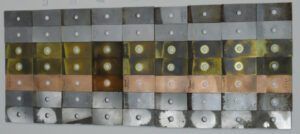
CONCLUSION
So, what does PS recommend? There are dozens of combinations that will work well and dozens of products that are either redundant, don’t actually work or can make things worse.
For HUM bug control, Biobor JF remains our top pick. It has performed predictably for many years and the FAA and airports don’t mess around. It is also an effective lubricity additive, killing two birds with one stone. For corrosion control, we like to pair it with Star Tron Enzyme Fuel Treatment, STA-BIL® Diesel, Stanadyne Performance, Biobor MD, or Power Service +Cetane Boost. If cetane is not a big issue for you, and we don’t think it is, then Biobor JF will control bugs and add lubricity, and STA-BIL® Diesel will stop corrosion. Most importantly, focus on clean fresh fuel. Inspect for rain and seawater leaks, install a vent filter and check your filters at least annually.

We’ve been disappointed by many lesser-known additive brands and some have proven downright harmful. We also actively recommend avoiding any product that contains glycol ethers for water dispersion and tank cleaning. They can do more harm than good.
| VALUE GUIDE | |||||||||
|---|---|---|---|---|---|---|---|---|---|
| Diesel Additive Corrosion and Performance Testing | Biocides | Performance and Storage Additives | |||||||
| Manufacturer | Sealed Control | Hamond's | Gold Eagle | Power Service | Valve Tech | Standyne | Power Service | Star Brite | Gold Eagle Chemical |
| Model | Biobor JF | Biobor JF+ Sta-bil Diesel | Diesel Klean Plus Cetane Boost + Stabil Diesel | Bioguard | Performance Formula | Diesel Klean Plus Cetane Boost | Star Tron Diesel | Sta-bil Diesel | |
| Name | for phase II testing | ||||||||
| Container size, oz. | 16 | hybrid | hybrid | 32 | 16 | 26 | 16 | 32 | |
| Price, $ | 29.99 | hybrid | hybrid | 39.99 | 7.99 | 13 | 25.99 | 34.99 | |
| Gallons treated | 1280 | hybrid | hybrid | 375 | 60 | 78 | 512 | 320 | |
| Cost to treat, $/gallon | 0.02 | 0.07 | 0.28 | 0.11 | 0.13 | 0.17 | 0.05 | 0.11 | |
| Features | Dispenser bottle | Dispenser bottle | Dispenser bottle | ||||||
| Features | |||||||||
| Features | |||||||||
| 6 weeks | |||||||||
| Corrosion Ratings. 1 month with 0.03% seawater | |||||||||
| Brass | 0 | 2 | 1 | 1 | 3 | 2 | 1 | 1 | 1 |
| Aluminum | 0 | 3 | 0 | 2 | 0 | 3 | 2 | 0 | 0 |
| Steel | 0 | 10 | 1 | 4 | 3 | 10 | 4 | 0 | 4 |
| Brass | 0 | 2 | 1 | 1 | 3 | 2 | 1 | 1 | 1 |
| Steel | 0 | 10 | 1 | 3 | 3 | 4 | 3 | 0 | 5 |
| Copper | 0 | 2 | 0 | 2 | 3 | 2 | 2 | 0 | 1 |
| Steel bottom sample | 0 | 2 | 1 | 2 | 1 | 3 | 2 | 1 | 2 |
| Recommended for Lubricity and HUM bugs | Recommended combination for HUM bugs, corrosion, and Lubricity | Recommended combination for HUM bugs, corrosion, and Lubricity | Recommended for HUM bugs | Recommended cetane boost only | Recomended for corrosion only | Recommended for corrosion only | |||
| Best Choice, Budget Buy | |||||||||
| 0 - same as sealed control | |||||||||
| 1 - light staining | |||||||||
| 2 - heavy staining | |||||||||
| 3 - 9 pitting | |||||||||
| 10 - heavy pitting equivalent to vented control with corrosive water | |||||||||
| - |








































I just received the last printed issue. it will be missed, no computer on boat, and reading on the phone is too small.
Al Halpern,
For years I have been using a product called Marine Dee-Zol by Bell performance. This stuff was highly recommended by my diesel mechanic and seems to work on keeping the tank clean and eliminating most of the exhaust smoke. I was suppressed to not see it discussed in the recent article and was just wondering why.
Drew any recommendations for how long the biocides you recommend will last on the shelf?
Re. Shelf life. The advice we have received on biocides and additives in general is that 2-3 years opened and 10 years unopened is OK. This squares with our experience; we’ve re-tested opened bottles stored in cool locations as old as 15 years and noted only minimal changes. So if it takes you a few seasons to use it up, that’s fine.
Thank you SO MUCH for addressing both types of diesel performance additives. Excellent report!